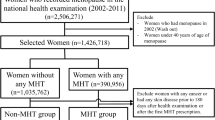Abstract
Data sources Data was from The Health Improvement Network (THIN) database from January 1999 to May 2016.
Study selection This was a series of population-based, case-control studies looking to evaluate the association between hydrochlorothiazide (HCTZ) exposure and skin, lip and oral cancer in the UK population.
Case/control selection Using the THIN database, patients with the following outcomes were grouped: squamous cell carcinoma (SCC) skin cancer; basal cell carcinoma (BCC) skin cancer; melanoma; lip cancer and oral cancer. Patients within the lip cancer and oral cancer groups were accepted with a history of non-melanoma skin cancer (NMSC). Patients in the SCC and BCC groups were not accepted with a history of cancer. Patients with a history of organ transplantation, human immunodeficiency virus (HIV) or immunosuppressant drug use before the index date were not accepted, due to the risk of predisposition to cancer. Controls were randomly selected using incidence density sampling. Up to 100 controls were randomly selected, matched on sex, exact year of birth and calendar year of cohort entry for lip cancer. However, for the remaining outcomes, only 20 controls were matched as above. Adults with incident NMSC, melanoma, lip cancer and oral cancer were matched to controls. Incidence rate ratios (IRRs) for the aforementioned outcomes were calculated for every cumulative HCTZ exposure.
Data analysis Odds ratios were calculated using conditional logistic regression. Associations were presented using a two-year HCTZ exposure lag-time and a five-year HCTZ exposure lag-time. Associations were evaluated using sensitivity analysis, restricted to patients with at least ten years' follow-up. There was adjustment for smoking status and BMI. Published incidence rates were used to calculate the absolute risk estimate for SCC as the incidence of SCC in the cohort was less than expected. For high-dose cumulative HCTZ exposure, the number of patients needed to treat to cause one additional cancer (number needed to harm) per year overall was estimated using rate differences. Analysis was carried out using SAS Enterprise Guidev7.1 and STATAv15.
Results Relative incidence of SCC, BCC and lip cancer was significantly elevated with every use of HCTZ. Relative incidence of melanoma and oral cancer was not significantly elevated with HCTZ exposure. Smoking was inversely associated with BCC and melanoma risk, but significantly increased the risk of lip and oral cavity cancers. SCC risk was not strongly associated with smoking. Significantly reduced risk of SCC, BCC melanoma and oral cavity cancer was associated with a BMI ≥30 kg/m2.
Conclusions The risk of NMSC and lip cancer in a UK population is increased with cumulative high-dose HCTZ exposure. It is therefore important for dentists to note as it may increase suspicion of lesions in patients taking these medications.
This is a preview of subscription content, access via your institution
Access options
Subscribe to this journal
Receive 4 print issues and online access
$259.00 per year
only $64.75 per issue
Buy this article
- Purchase on Springer Link
- Instant access to full article PDF
Prices may be subject to local taxes which are calculated during checkout
Similar content being viewed by others
References
Kunisada M, Masaki T, Ono R et al. Hydrochlorothiazide enhances UVA-induced DNA damage. Photochem Photobiol 2013; 89: 649-654.
International Agency for Research on Cancer. Some Drugs and Herbal Products: IARC Monographs on the Evaluation of Carcinogenic Risks to Humans. Lyon: International Agency for Research on Cancer, 2015.
Pedersen S A, Gaist D, Schmidt S A J, Hölmich L R, Friis S, Pottegård A. Hydrochlorothiazide use and risk of nonmelanoma skin cancer: a nationwide case-control study from Denmark. J Am Acad Dermatol 2018; DOI: 10.1016/j.jaad.2017.11.042.
Pottegård A, Hallas J, Olesen M et al. Hydrochlorothiazide use is strongly associated with risk of lip cancer. J Intern Med 2017; 282: 322-331.
Pottegård A, Paedersen S A, Schmidt S A J, Hölmich L R, Friis S, Gaist D. Association of Hydrochlorothiazide use and Risk of malignant melanoma. JAMA Intern Med 2018; 178: 1120-1122.
Jensen A, Thomsen H F, Engebjerg M C, Olesen A B, Sørensen H T, Karagas M R. Use of photosensitising diuretics and risk of skin cancer: a population-based case-control study. Br J Cancer 2008; 99: 1522-1528.
Schmidt S A J, Schmidt M, Mehnert F, Lemeshow S, Sørensen H T. Use of antihypertensive drugs and risk of skin cancer. J Eur Acad Dermatol Venereol 2015; 29: 1545-1554.
Blak B T, Thompson M, Dattani H, Bourke A. Generalisability of the health improvement network (THIN) database: demographics, chronic disease prevalence and mortality rates. Inform Prim Care 2011; 19: 251-255.
Author information
Authors and Affiliations
Rights and permissions
About this article
Cite this article
Carney, K., Cousins, M. Does hydrochlorothiazide increase the incidence of skin, lip and oral cancer in a UK population?. Evid Based Dent 23, 38–39 (2022). https://doi.org/10.1038/s41432-022-0255-x
Received:
Accepted:
Published:
Issue Date:
DOI: https://doi.org/10.1038/s41432-022-0255-x



